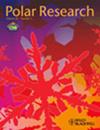Extremely high abundances of Prasiola crispa-associated micrometazoans in East Antarctica
IF 1.3
4区 地球科学
Q3 ECOLOGY
引用次数: 2
Abstract
To elucidate poorly known aspects of the microscopic metazoan distribution in ice-free parts of the Antarctic, we examined samples of the multicellular terrestrial alga Prasiola crispa, collected over the last decade in different parts of continental East Antarctica and Haswell Island. We found that the micrometazoans inhabiting the algae consist of remarkably abundant bdelloid rotifers (subclass Bdelloidea), followed by tardigrades. We did not find nematodes. The rotifer assemblages were characterized by low diversity (only six species). Nevertheless, rotifer densities were extremely high: mean densities ranged from 75 to 3030 individuals per 100 mg of the dry sample weight and the maximum value numbered in excess of 8000 per 100 mg of the dry sample weight. These data show that terrestrial algae, along with mosses, are a very attractive habitat for rotifers and tardigrades in the Antarctic. The statistical analysis showed a lack of correlations between rotifer and tardigrade densities and nutrients (N, C, P, K and Na). Our findings are consistent with the patchy distribution of terrestrial micrometazoans in the Antarctic that has previously been found.在东南极洲有极其丰富的与crispa Prasiola相关的微后生动物
为了阐明南极无冰地区微观后生动物分布的鲜为人知的方面,我们检查了过去十年在南极洲东部大陆和Haswell岛不同地区收集的多细胞陆生藻类crispa样本。我们发现居住在藻类中的微后生动物包括非常丰富的蛭形轮虫(蛭形亚纲),其次是缓步动物。我们没有发现线虫。轮虫群落多样性较低,仅有6种。然而,轮虫密度极高:每100毫克干样品重量的平均密度为75至3030只,每100毫克干样品重量的最大值超过8000只。这些数据表明,陆生藻类和苔藓是南极轮虫和缓步动物非常有吸引力的栖息地。统计分析表明,轮虫和缓步动物密度与养分(N、C、P、K和Na)之间缺乏相关性。我们的发现与之前在南极发现的陆生微后生动物的斑块分布一致。
本文章由计算机程序翻译,如有差异,请以英文原文为准。
求助全文
约1分钟内获得全文
求助全文
来源期刊

Polar Research
地学-地球科学综合
CiteScore
3.20
自引率
5.30%
发文量
22
审稿时长
>12 weeks
期刊介绍:
Since 1982, Polar Research has been the international, peer-reviewed journal of the Norwegian Polar Institute, Norway''s central institution for research, environmental monitoring and mapping of the polar regions. Aiming to promote the exchange of scientific knowledge about the Arctic and Antarctic across disciplinary boundaries, Polar Research serves an international community of researchers and managers. As an open-access journal, Polar Research makes its contents freely available to the general public.
Original primary research papers comprise the mainstay of Polar Research. Review articles, brief research notes, letters to the editor and book reviews are also included. Special issues are published from time to time.
The scope of Polar Research encompasses research in all scientific disciplines relevant to the polar regions. These include, but are not limited to, the subfields of biology, ecology, geology, oceanography, glaciology and atmospheric science. Submissions from the social sciences and those focusing on polar management and policy issues are welcome. Contributions about Antarctica are particularly encouraged.
 求助内容:
求助内容: 应助结果提醒方式:
应助结果提醒方式:


